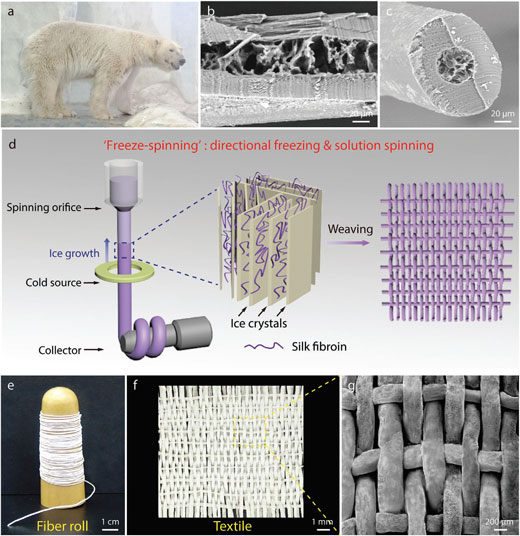| Posted: Feb 16, 2018 | |
Polar bear hair inspires nanotechnology enhanced thermal textile(Nanowerk News) Inspired by the microstructure and thermal insulation function of the polar bear hair, scientists have used a freeze-spinning technique to continuously fabricate silk fibroin solution into a fiber with aligned porous microstructure. |
|
| The textile woven with the biomimetic fibers has an excellent thermal insulation, active electroheating capacity when doped with carbon nanotubes (CNTs), good wearability and breathability, making it a promising material for thermal insulation and personal thermal management. | |
| This work by researchers at Zhejiang University in China has been reported in Advanced Materials ("A Thermally Insulating Textile Inspired by Polar Bear Hair"). | |
 |
|
| Polar bear hair with hollow core and aligned shell, and continuous and large-scale fabrication of biomimetic porous fiber. a) Photograph of a polar bear. b,c) SEM images showing the hollow core and aligned shell of a polar bear hair, respectively. d) Schematic illustration of the “freezespinning” technique, combining “directional freezing” with “solution spinning” to realize continuous and large-scale fabrication of biomimetic fibers with aligned porous structure, mimicking the polar bear hair. The silk fibroin solution extruded from a pump-controlled syringe is gradually frozen when it passes through a cold copper ring. Collected by a motor, the frozen fiber is further freeze-dried to reserve its porous structure and subsequently woven into a textile. e) Optical image showing a porous fiber collected in a roll. f,g) Optical (f) and SEM (g) images showing a woven textile of biomimetic porous fiber. The fiber diameter is around 200 µm. (© Wiley-VCH Verlag) (click on image to enlarge) | |
| The team uses a freeze-spinning method to realize continuous and large-scale fabrication of fibers with aligned porous structure, mimicking polar bear hairs, which is difficult to achieve by other methods. | |
| Textile woven with such biomimetic fibers shows an excellent thermal insulation property as well as good breathability and wearability. | |
| In addition to passively insulate heat loss, the textile could also function as a wearable heater, when doped with electroheating materials such CNTs, to induce fast thermal response and uniform electroheating while maintaining its soft and porous nature for comfortable wearing. |
 By
Michael
Berger
– Michael is author of three books by the Royal Society of Chemistry:
Nano-Society: Pushing the Boundaries of Technology,
Nanotechnology: The Future is Tiny, and
Nanoengineering: The Skills and Tools Making Technology Invisible
Copyright ©
Nanowerk LLC
By
Michael
Berger
– Michael is author of three books by the Royal Society of Chemistry:
Nano-Society: Pushing the Boundaries of Technology,
Nanotechnology: The Future is Tiny, and
Nanoengineering: The Skills and Tools Making Technology Invisible
Copyright ©
Nanowerk LLC
|
|
|
Subscribe to a free copy of one of our daily Nanowerk Newsletter Email Digests with a compilation of all of the day's news. |
